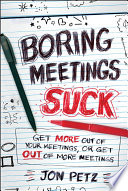

Meetings are often viewed as a necessary evil in the workplace, but the book emphasizes the hidden costs associated with them. Each meeting not only consumes time but also resources, energy, and morale. The authors argue that organizations need to quantify the time spent in meetings and understand the opportunity cost of that time. When employees are pulled away from productive tasks to attend meetings that lack purpose, it can lead to frustration and disengagement. The book encourages readers to analyze the frequency and duration of meetings and to consider whether the same outcomes could be achieved through more efficient means, such as emails or collaborative tools. By being more mindful of the time spent in meetings, organizations can improve productivity and employee satisfaction.
Continue readingOne of the central themes of the book is the importance of establishing clear objectives for every meeting. Meetings should never be held without a defined purpose or agenda. The authors stress that having a clear objective not only helps in keeping the meeting focused but also allows participants to prepare adequately. This preparation leads to more meaningful discussions and better outcomes. The book provides practical tips on how to set objectives, such as asking what decisions need to be made or what problems need to be solved during the meeting. By ensuring that every meeting has a clear purpose, organizations can reduce the number of unnecessary gatherings and enhance the effectiveness of those that do occur.
Continue readingAnother critical idea presented in the book is the necessity of inviting only the relevant participants to meetings. Too often, meetings are filled with individuals who do not contribute to the agenda, leading to wasted time and resources. The authors advocate for a more selective approach to meeting invitations, suggesting that organizers should consider who truly needs to be involved in the discussion. This not only streamlines the meeting process but also empowers those who are invited to engage more meaningfully. The book encourages leaders to reevaluate their invitation lists and to communicate the importance of the meeting to those who are invited, ensuring that everyone present has a stake in the outcomes.
Continue readingThe book emphasizes the need for creating an inclusive environment during meetings. This means fostering a culture where all participants feel comfortable sharing their ideas and opinions. The authors suggest techniques for encouraging participation, such as round-robin discussions or anonymous feedback tools. By ensuring that everyone has a voice, organizations can benefit from diverse perspectives and ideas, leading to more innovative solutions. The book highlights that inclusivity not only improves the quality of discussions but also enhances team cohesion and morale, making participants feel valued and respected.
Continue readingIn an era where technology is ubiquitous, the book discusses how to leverage it effectively to enhance meetings. While technology can facilitate remote participation and streamline communication, it can also lead to distractions and disengagement if not used wisely. The authors recommend choosing the right tools for the meeting's purpose, whether it's video conferencing software, collaborative platforms, or project management apps. They also caution against over-reliance on technology, advocating for a balance between digital tools and face-to-face interactions. By utilizing technology thoughtfully, organizations can make meetings more efficient and engaging.
Continue readingThe book highlights the importance of follow-up after meetings to ensure accountability and track progress. Many meetings end with action items that are quickly forgotten, leading to a lack of follow-through. The authors propose establishing a clear system for documenting decisions and assigning responsibilities during the meeting. They also recommend sending out meeting notes and action items promptly to keep everyone on the same page. By creating a culture of accountability, organizations can ensure that meetings lead to tangible results and that participants remain engaged in the outcomes.
Continue readingFinally, the book calls for a broader rethinking of organizational meeting culture. It challenges the status quo that meetings are an inherent part of work life and encourages leaders to question the necessity of each meeting. The authors promote the idea of creating a culture where meetings are seen as a last resort, rather than the default method of communication. This shift in mindset can lead to more efficient use of time and resources, ultimately enhancing productivity and employee satisfaction. The book provides strategies for initiating this cultural change, including leadership buy-in and employee engagement.
Continue reading